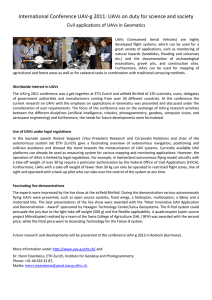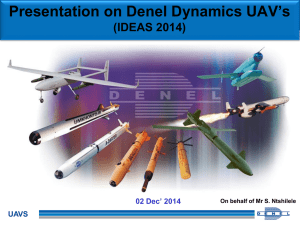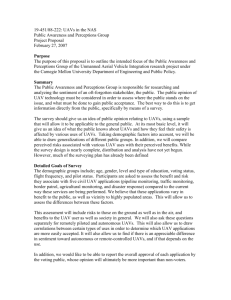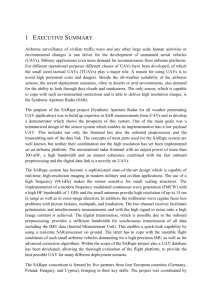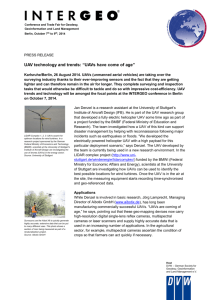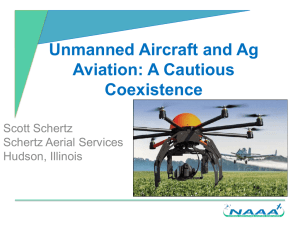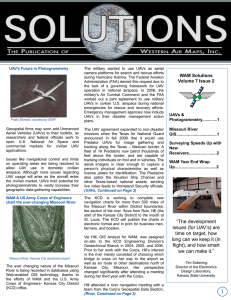pdf - Perley-Robertson, Hill & McDougall
advertisement
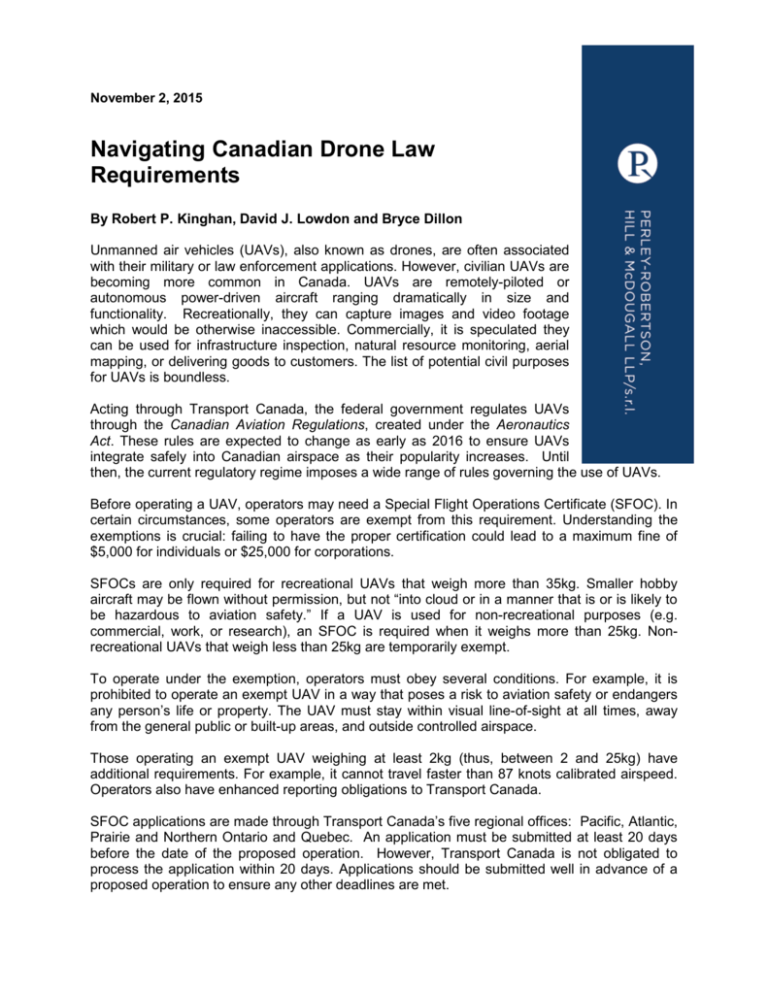
November 2, 2015 Navigating Canadian Drone Law Requirements By Robert P. Kinghan, David J. Lowdon and Bryce Dillon Unmanned air vehicles (UAVs), also known as drones, are often associated with their military or law enforcement applications. However, civilian UAVs are becoming more common in Canada. UAVs are remotely-piloted or autonomous power-driven aircraft ranging dramatically in size and functionality. Recreationally, they can capture images and video footage which would be otherwise inaccessible. Commercially, it is speculated they can be used for infrastructure inspection, natural resource monitoring, aerial mapping, or delivering goods to customers. The list of potential civil purposes for UAVs is boundless. Acting through Transport Canada, the federal government regulates UAVs through the Canadian Aviation Regulations, created under the Aeronautics Act. These rules are expected to change as early as 2016 to ensure UAVs integrate safely into Canadian airspace as their popularity increases. Until then, the current regulatory regime imposes a wide range of rules governing the use of UAVs. Before operating a UAV, operators may need a Special Flight Operations Certificate (SFOC). In certain circumstances, some operators are exempt from this requirement. Understanding the exemptions is crucial: failing to have the proper certification could lead to a maximum fine of $5,000 for individuals or $25,000 for corporations. SFOCs are only required for recreational UAVs that weigh more than 35kg. Smaller hobby aircraft may be flown without permission, but not “into cloud or in a manner that is or is likely to be hazardous to aviation safety.” If a UAV is used for non-recreational purposes (e.g. commercial, work, or research), an SFOC is required when it weighs more than 25kg. Nonrecreational UAVs that weigh less than 25kg are temporarily exempt. To operate under the exemption, operators must obey several conditions. For example, it is prohibited to operate an exempt UAV in a way that poses a risk to aviation safety or endangers any person’s life or property. The UAV must stay within visual line-of-sight at all times, away from the general public or built-up areas, and outside controlled airspace. Those operating an exempt UAV weighing at least 2kg (thus, between 2 and 25kg) have additional requirements. For example, it cannot travel faster than 87 knots calibrated airspeed. Operators also have enhanced reporting obligations to Transport Canada. SFOC applications are made through Transport Canada’s five regional offices: Pacific, Atlantic, Prairie and Northern Ontario and Quebec. An application must be submitted at least 20 days before the date of the proposed operation. However, Transport Canada is not obligated to process the application within 20 days. Applications should be submitted well in advance of a proposed operation to ensure any other deadlines are met. Each SFOC will contain a range of safety rules and reporting obligations. For example, UAV flights beyond the pilot’s visual line-of-sight will generally not be permitted in shared airspace without an acceptable collision avoidance system. Failing to abide by these provisions can lead to a maximum fine of $3,000 for individuals and $15,000 for corporations. Although there are currently no licensing requirements to control (or pilot) UAVs, pilots must possess several default competencies to obtain an SFOC. At a minimum, pilots must be 18 years old and medically fit. Additional qualifications may be required on a case-by-case basis. The rules for flying UAVs in Canada are detailed, complex, and subject to a number of exceptions. Moreover, the laws and regulations will inevitably evolve in response to popular demand and commercial needs. Perley-Robertson, Hill & McDougall LLP/s.r.l. can help companies and individuals navigate the constantly changing rules governing UAVs. Robert P. Kinghan is a Partner and Head of the Business Law Group at Perley-Robertson, Hill & McDougall. He can be reached at rkinghan@perlaw.ca or 613.566.2848. To view his bio, please click here. David J. Lowdon is an Associate in the Business Law Group at Perley-Robertson, Hill & McDougall. He can be reached at dlowdon@perlaw.ca or 613.566.2809. To view his bio, please click here. Bryce Dillon is currently a Student-at-Law at Perley-Robertson, Hill & McDougall. He can be reached at bdillon@perlaw.ca or 613.238.2022.


